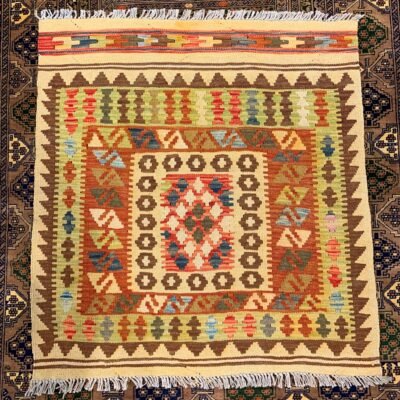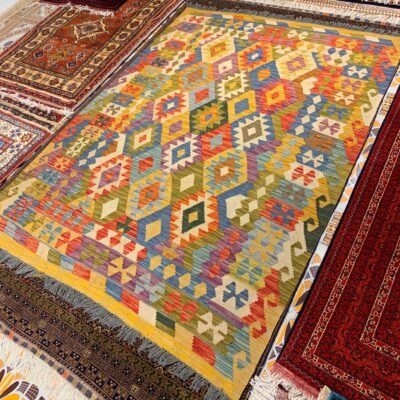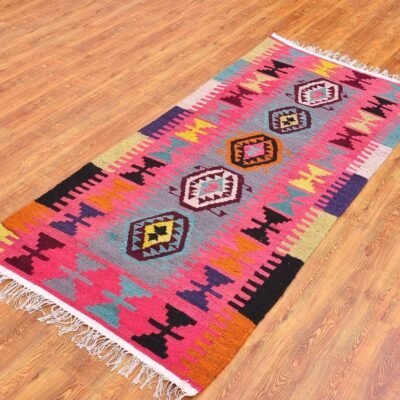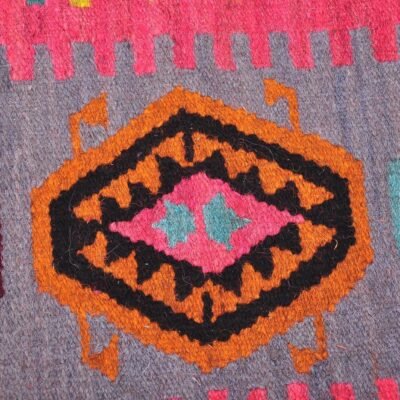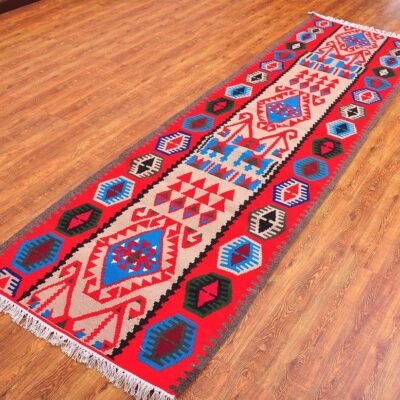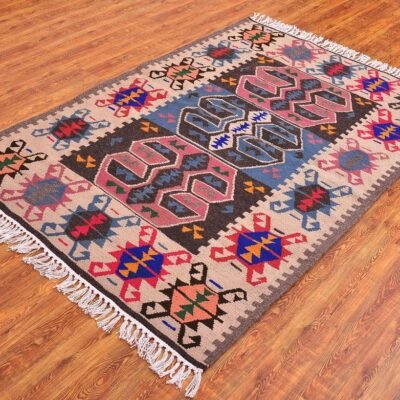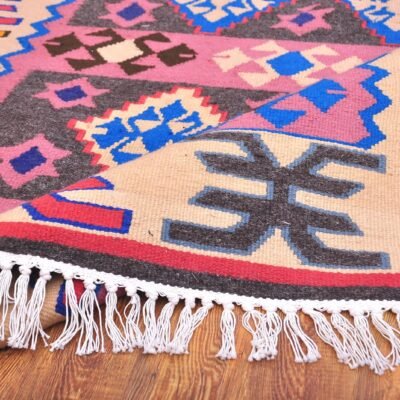History and Origin of Kilim Rugs
Kilim rugs have existed for centuries. The word kilim, pronounced kee-leem, is of Turkish origin, and it is also presumed that some of the first kilims might originate from the area and parts of Central Asia. Research shows that some of the earliest signs of people using kilim rugs date to the Bronze Age when women in various tribes would weave kilims and use them as floor coverings.
The historical background of kilims reveals that these decorative pieces have been part of communities for a long time. They were not just used as floor coverings but also played a significant role in trade markets and were incorporated into various wedding and prayer rituals. In fact, the origin of kilim rugs is believed to be closely connected to prayer, as people used them when praying, underscoring the cultural value of these rugs.
Nowadays, kilim rugs are available in various versions, each with its own purpose. Some are used for prayer, others as floor coverings, and some as simple decorative pieces. The motifs and symbols represented on the kilim can vary, but they always captivate those who appreciate the true background of the designs. Each region of origin has unique motifs and symbols, which we will delve into in another section.
Regional Kilim Rug Variations
As mentioned, kilim rugs can vary depending on the region of origin. The differences are most noticeable in the patterns or colours used, while the weaving techniques can also vary slightly.
At Alesouk, we have a separate section dedicated to handwoven and authentic rugs. Our offerings include Turkish, Turkmen, Persian, and Afghan rugs, while there is a separate section on kilim rugs. You can learn more about our Turkish, Uzbek, and Afghan rugs in that section. Here's more on the key features of each one:
Turkish Kilim Rugs
Turkish or Anatolian kilim rugs have very vibrant colours and bold geometric patterns. A specific weaving technique is used in the making, allowing the kilims to have intricate designs. Some of the common symbols you will see on these kilims include floral symbols, plants, leaves, and geometric symbols. Due to the quality fibres used in the making of these kilims, you can rest assured that they will last for years after you purchase them without showing any signs of deterioration.
Uzbek Kilim Rugs
Uzbek kilim rugs have significantly influenced the country's trade market. In fact, they were commonly used during the Silk Road trades. They are easily distinguishable from other kilim rugs in the use of vibrant red hues, natural dyes, and floral motifs. Furthermore, they include various important symbols for the country's culture and beliefs, such as fruit for fertility, the sun for good luck, etc.
Afghan Kilim Rugs
Afghan kilim rugs are similar to the other two groups in the colours used, but the symbols vary slightly. Besides the geometric shapes regularly used in the designs, Afghan kilim rugs tend to have some animals and plants represented as well. Furthermore, all the traditional kilim rugs are made with natural dyes, predominantly earthy tones, reds, yellows, etc. Apart from floor coverings, these rugs are commonly used as decoration, as the designs are always symbolic and reflect the beliefs and heritage of the Afghan people.
Kilim Rug Designs, Patterns, and Materials
When discussing authentic, hand-woven kilim rugs, it's easy to assume that no two rugs are the same. They vary in the designs, motifs, and materials used in the making. Next up, we will discuss the common kilim materials and patterns and shapes you can notice on most of these kilims:
Kilim Rug Designs
When discussing authentic and hand-woven kilims, each kilim rug for sale is different from any other. However, the designs usually incorporate the following four categories of symbols:
- Tribal symbols: Tribal symbols are very interesting to explore, as they show what makes each tribe special and unique. Sometimes, kilim rugs show eyes, representing protection and the belief that there’s always someone watching over them. Other times, praying hands or religious items might be represented. The symbols vary greatly.
- Animal symbols: Various animals are included in the design of kilim rugs to symbolise what people believed in or what they were working with at a specific time in the past. Thus, some kilims include mythological creatures while others show horses, birds, cows, and other domestic animals that people looked after.
- Floral symbols: Botanical symbols are common in kilim rugs, whether representing flowers, leaves, or plants. Some kilim rugs even include nothing but flowers in their designs, symbolising botanical or garden landscapes.
- Geometric symbols: Various geometric shapes are included in the designs of these kilims. Some, like the diamond shape, symbolise women’s figures and are used to symbolise fertility. Others include squares, circles, some irregular shapes, etc.
Kilim Rug Patterns
The patterns shown on various kilim rugs depend on the weaving techniques used by the people creating them. Unlike machine-made rugs, the rugs that we sell at Alesouk are fully hand-made and hand-woven with a specific technique called hand-looming, something that is unique to the Uzbek region. Other regions use flat weaving, braiding, etc.
A fully hand-operated machine is used for hand-looming, and the fibres are also dyed with natural dyes. After the entire rug is weaved, the process is finished by trimming any loose threads and washing the rug to remove any remaining threads, dye, and dust.
Kilim Rug Materials
Various materials can be used to make rugs, but the traditional kilim rugs for sale at Alesouk include only three materials - wool, cotton, and silk. Here’s more on the properties of each one:
- Wool kilim rugs: Wool is one of the best material options for kilim rugs because it is very durable and can handle high traffic without showing signs of tear. This is because wool is water and stain-resistant. Furthermore, the fibres can easily hold various dyes but remain soft and luxurious-looking. Wool kilim rugs are also an excellent choice for the living room and other parts of your home, as they can add to the look of any area.
- Cotton kilim rugs: Cotton is very absorbent and breathable, making it a great choice for decorative kilim rugs. It might not be best for high-traffic areas, as it is more high-maintenance than the other options. Nevertheless, it is a cost-effective option that can be customised as much as you want, so you can get the exact design and colours that fit your space.
- Silk kilim rugs: Silk was used only by wealthier families to make kilim rugs. Nowadays, it is more common to find it mixed into cotton or wool kilim rugs as an accent to enhance the overall look and feel. However, the price and delicacy of this type of fibre do not make it a good option for kilims unless you are okay with paying more and maintaining the rug often to keep it in pristine shape.
How to Maintain a Kilim Rug?
You've decided to purchase a kilim rug from Alesouk? How amazing! Now, it's time to learn how to maintain the rug to keep it in its initial state.
Namely, the first thing you should remember is that the kilim rug, like all other rugs, needs vacuuming at least a few times monthly. Depending on how heavy the foot traffic is in the area, you might need to do this more often.
Next in line is the occasional spot cleaning, which you can do as needed. If you notice spots or accidentally spill something on the carpet, try to clean it as soon as possible. Blotting on the spot is better than scrubbing to avoid damage. Also, clean with a clean cloth that you dip in a mixture of water and mild detergent. We recommend not using any strong chemicals on these carpets, as the natural dyes might be affected.
Deep cleaning is also wise and should be done at least once per year. Leave this to professionals, who will know how to clean the kilim rug to remove all dirt and debris while preserving the weave and dye.
Finally, we recommend that you avoid placing these rugs in direct sunlight for long, as that can also affect the colour. If you have kilim rugs, try using window coverings or curtains, and rotate the rugs often to ensure all areas get equal exposure to sunlight.
Where to Find Authentic Kilim Rugs?
Finding authentic kilim rugs might not be as easy as you assume, considering mass manufacturing is widespread. However, at Alesouk, we have only handwoven and authentic kilim rugs to offer.
If you look into our section dedicated to kilim rugs, you will also find them divided according to the regions where they originate from. Our offerings usually include Turkish, Afghan, and Uzbek cotton, silk, and wool kilim rugs. All come at affordable prices and a 100% satisfaction guarantee. If for any reason you're not satisfied with your purchase, we have a hassle-free return policy.
Visit Alesouk, find your ideal kilim rug, and order it today. For any details, feel free to contact us!
FAQs on Kilim Rugs
Are kilim rugs expensive?
Prices of kilim rugs can vary greatly. First, authentic, hand-woven kilim rugs are generally more expensive than mass-produced ones. Then, kilim rugs made with natural fibres and dyes are more expensive than kilims made with synthetic fibres. Finally, the size and design complexity can also influence the price, so consider that when making your final purchase decision.
Are kilim rugs suitable for high-traffic areas?
Kilim oriental rugs are durable, meaning they can be used in high-traffic areas. We recommend them for indoor rather than outdoor areas and homes instead of commercial spaces. While they can handle a lot of traffic, they can easily become dirty and require regular maintenance.
Can kilim rugs be repaired for damage?
Usually, kilim rugs can be repaired if they sustain damage. That includes patching holes, re-weaving certain areas, securing loose threads, etc. The only type of damage that is common but not easy to repair is fading colour, but you can always add some extra natural dye to try and fix the issue.


